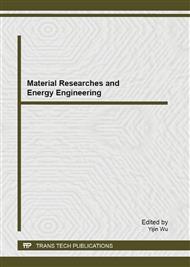p.461
p.467
p.474
p.480
p.487
p.495
p.501
p.507
p.513
Co-Combustion of Paper Mill Sludge and Bituminous Coal in Air Using Thermogravimetric Analyzer
Abstract:
The combustion of paper mill sludge and bituminous coal in air was analyzed using a thermogravimetric instrument. TG and DTG curves for the blends lies between that of the individual fuels, and the main combustion characteristics of blends depended on individual fuels and followed the weighted average. As the blending ratio of paper mill sludge was increased from 10% to 90%, the ignite temperature (Ti) decreased from 529.6°C. to 275.6°C., and residual weight increased from 19.28% to 47.39%. The TG profiles of sample were almost the same at different heating rates, however there was a big difference between the DTG profiles. The maximum weight loss rate of sample increased obviously with the increment of heating rate. This work contributes to the comprehensive understanding of paper mill sludge and bituminous coal combustion and development of co-combustion technology.
Info:
Periodical:
Pages:
487-494
Citation:
Online since:
September 2013
Authors:
Keywords:
Price:
Сopyright:
© 2013 Trans Tech Publications Ltd. All Rights Reserved
Share:
Citation:


